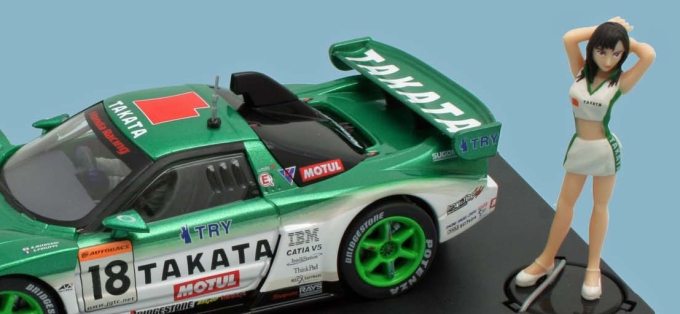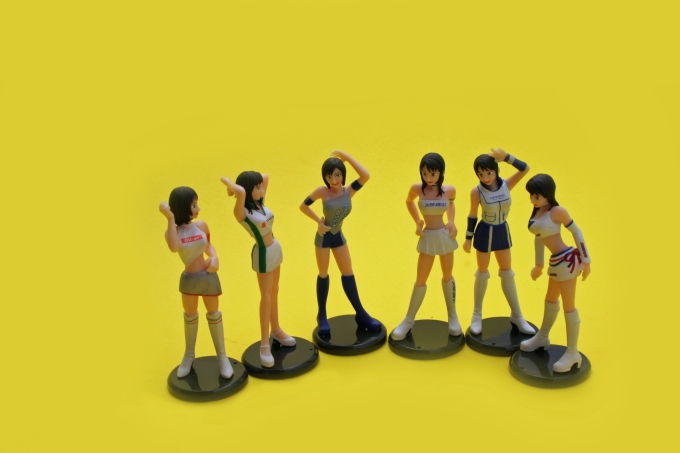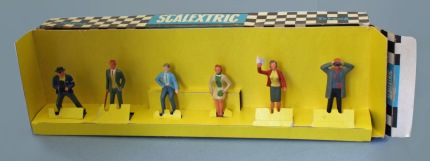Meet the fairer sex in the Scalextric family – or do I mean the female gender or feminine genre?

No, wait! No need to be overly politically sensitive here. We’re only reviewing plastic toys.
An entire ‘family’ have existed in the Scalextric range snce 1961. Unfortunately, the individuals concerned didn’t age a day for over forty years or changed their dress sense. So, let’s look at how the fairer sex was represented in the Scalextric range since the Scalextric-man first set foot in this World.
The Ascent of Scalextric Wo-Man: In 1961, two ladies appeared in the first Scalextric figure Set F301 Spectators & Press Photographers which contained six figures. One lady is sitting and often painted in blue and green. The other lady stands holding aloft a white pamphlet. Let’s christen them ‘Sita’ and ‘Pammie’! The figures were moulded in pink plastic and remained in the official range throughout the 60s until 1971.
A second Set of figures, F305 Press & Vendors (6 figures) was also released in 1961 that only contained one standing female figure decorated in a green outfit and green hat. I’ll call her ‘Hattie’. She appears to be selling programmes or similar. This accessory set is harder to find. The boxes for F300-301-302-303-304-305 came with blue or yellow inner cards. The ‘F’ series figures were produced in pink plastic and pre-painted at the factory. Be careful today, though, as the paint is prone to flake off very easily.
In 1963, F306A Grandstand figures kit (5 figures as one piece and unpainted) and F306B Grandstand figures kit (5 figures as one piece and unpainted) entered the range. These pair of Scalextric ‘Famous Fives’ figures were intended for the grandstands, you would imagine, and offered in the range as plain unpainted pink plastic figures for the enthusiast to decorate in whatever colours the enthusiast preferred. Unfortunately, they do not ‘sit’ well on a grandstand bench and would fall forward as a group. They could of course be used anywhere on a circuit that seemed appropriate but ‘empty Grandstands’, as is the case to this very day, was the eventual outcome.
F306A’s group of seated figures had a lady resting her head on the shoulder of the man to her right. Let’s refer to her as the ‘Lena. F306B’s group has a lady at the end of the group sitting next to, perhaps, her son and husband. I’ll name her ‘Endora’.
In 1971, Scalextric figures appeared to have been made extinct, none were in the catalogue! Further releases of F301 and F306A & B in rebranded packaging appeared during the next 25 years to ‘top up’ thinning retail stocks. Easily confused with the earlier soft pink plastic characters the later range was produced in a harder cream-coloured plastic but painted in the same colours! The seated grandstand figures appeared in both painted and unpainted forms in white, cream and brown base colours – as did the standing spectators.
On the top row sits ‘Lena’, leaning on her boyfriend and at the end of the lower row is ‘Endora. Second picture: ‘Pammie’ holds a programme aloft and ‘Sita’ sitting pretty, both with full ‘make-up’ – being pre-painted. On the right, the unpainted grey/brown versions sold in accessory packs.

Here’s a family album photograph of part of the 20th Century extended Scalextric family!
By the 21st century demand for figures to adorn a scenic Scalextric layout was growing with the recent introduction of modern trackside buildings and in 2004 the next evolution of Scalextric man appeared modelled as pit crews were introduced and dressed in the style of modern F1 overalls and helmets in silver, blue and, for only two years, red crew liveries – but no female crew.
As far as figures of the fairer sex were concerned the tooling from the 20th Century was stuck in time…but then came Woman from Tokyo! “Talk about her like a Queen, Dancing in an Eastern Dream.” (Deep Purple lyric) Despite the need for modern figures for track layouts or dioramas this, all too brief, appearance from the Far East would be the last manifestation of female figures in the Scalextric range.

The grid girls were only produced, under license by Takara, in Japan along with their Japanese GT C car range and branded ‘Quattrox’. The ‘Scalextric Digital – ready’ cars were produced under license from Scalextric and sold principally in Japan in their TAKARA-Quattrox packaging. Each car came complete with a grid girl clipped in to the plastic base next to the race car. The SCALEXTRIC branded equivalents, sold in the UK and around the world, came WITHOUT a grid girl posing next to the car in its presentation case.

“Fly into the rising sun, Faces, smiling everyone. Yeah, she is a whole new tradition…” In the 1970s, Deep Purple seemed to have predicted what should happen in the next century – but ‘No’, Hornby decided that the girl figures weren’t politically correct! Imported by Scalextric to the UK market, the race car models didn’t have the grid girl figurines on the plinth.

From left-to-right:
Roku is the grid girl for the QX06 Toyota Supra GTC au Cerumo 38 car,
Shi is the grid girl for the QX04 Honda NSX GTC Takata 18 car,
Go is the grid girl for the QX05 Toyota Supra GTC Esso 6 car,
Ichi is the grid girl for the QX01 Nissan 350Z GTC Xanavi 1 car,
Ni is the grid girl for the QX02 Nissan 350Z GTC Calsonic 12 car,
San is the grid girl for the QX03 Honda NSX GTC Raybrig 100 car.
Whites, blues and greys are the principal decoration colours of these women from Tokyo though none were dressed in Deep Purple!
So, the female family tree is as follows:
1962 Pammie, Hattie and Sita
1963 Lena and Endora
2006 The six Japanese grid-girls: Ichi, Ni, San, Shi, Go and Roku.
Please refer to the Scalextric Ultimate Guide Edition 8 book, available from Pendle Slot racing and Scale Models, and the accompanying website slotcarportal.com for more information.










You must be logged in to post a comment.